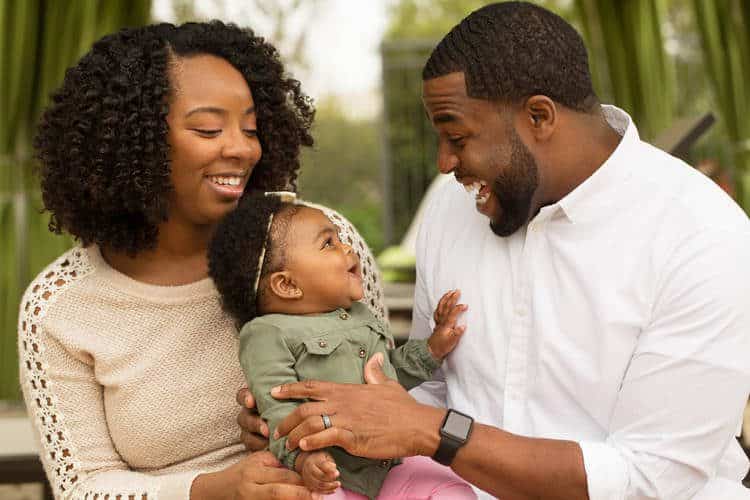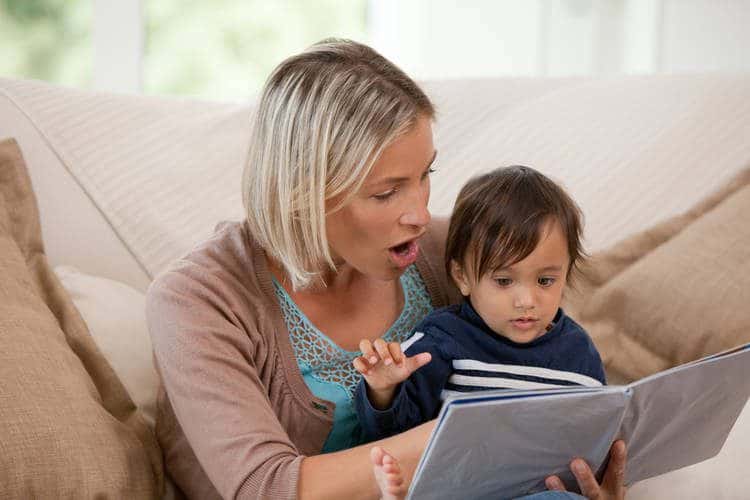This resource provides strategies to help parents and caregivers understand baby communication and support the development of communications skills in young children.
The capacity to communicate is the ability and desire to connect with others by exchanging ideas and feelings, both verbally and non-verbally. Most children learn to communicate to get a need met or to establish and maintain interaction with a loved adult.
Babies communicate from birth, through sounds (crying, cooing, squealing), facial expressions (eye contact, smiling, grimacing) and gestures/body movements (moving legs in excitement or distress, and later, gestures like pointing.) Babies continue to develop communication skills when adults respond to their efforts to “tell” others about what they need or want.
Children’s communication skills grow by leaps and bounds across the first few years of life:

- A newborn nuzzles at her mother’s breast. Her mother says, “Oh, you must be hungry. Here you go.” This baby is learning that her loved ones will respond to her signals and communications.
- A 9-month-old starts messing with the food on his high chair, as if wiping it clean with his hands. His father notices, saying: “Hey buddy, looks like you’re telling me you are all done. How about I take you out of there and we can head to the park.” This baby is learning that he is an effective communicator.
- A 28-month-old is at the park. She is pointing urgently at something and saying to her grandfather, “Derl! Derl! Derl!” He says, “I’m sorry, sweetie, I don’t understand. Could you say it again?” She continues to point, and repeats herself a number of times. Finally, her grandfather says, “Oh, the squirrel. Yes, I see him up there in the tree!” This toddler is learning that her loved ones will “hang in there” and work hard to understand her attempts to communicate.
- A 3-year-old chats with his mother on the way home from preschool. He tells her he liked the songs and snack, but didn’t like how the sand felt on his hands. His mother listens, and asks him questions. This toddler is learning that what he has to say is important to the people who love him, and that he is a good communicator.

Here are some ideas to help a baby or toddler develop communications skills:

Respond to the baby’s gestures, looks and sounds.
When he puts his arms out to you, pick him up, kiss him and use simple words. “You want up.” When he coos, coo back. When he gazes at you, make eye contact and talk with him. These immediate and attuned responses tell the baby that his communications are important and effective. This will encourage him to continue to develop these skills.
Talk with and listen to the child.
When you talk with her, give her time to respond. Make eye contact on her level. This will communicate your desire to hear what she has to say. Ask open-ended questions: “What do you think about today’s rainy weather?” “Where do you think the rain goes?” “How do you think the rain helps flowers grow?” “Why is the sky so gray?” Talking with the child helps her see herself as a good communicator and motivate her to keep developing these skills.
Help children build on their language skills.
“So you are pretending to be a hungry caterpillar who wants to eat some food? What kind of food? Let’s name all the things you want to eat.”
Teach the child about non-verbal communication.
“Luis, do you see how Andi is holding her hands up to cover her face? She doesn’t like it when you throw the ball so hard. I know you can throw it softer so she will want to keep playing catch with you.”
Respect and recognize the child’s feelings.
Children are far more likely to share their ideas and feelings if they know they won’t be judged, teased, or criticized. You can empathize with a child’s experience, yet disagree with his behavior. For example, “I know you’re scared to sleep alone, but you need to stay in bed. Would you like some quiet music on?” Or, “I know you’re angry but you can’t throw the blocks. Here’s a pillow you can punch instead.”
Help the child develop a “feelings” vocabulary.
Provide the words for her experience. “You’re sad because Daddy left for his trip.” Keep in mind that feelings are not good or bad, they just are. Sometimes parents are afraid that talking about an intense feeling will escalate it; but many times the opposite happens: When children feel that that their feelings and experiences are respected, they are often able to move on more easily.

Read together.
Cuddle together for quiet times with a book. Encourage your older baby to turn the pages and to point to what he sees. Ask your older toddler how the characters might be feeling and wonder together what will happen next. Let the child choose the books. The more interest he has in the book, the more attentive and enjoyable your time together will be. And reading with a child teaches more than literacy and language skills. He is learning that you value his interests and choices, and that you love him and enjoy being close to him. Studies show that lifelong readers are those who, as children, simply found reading a pleasurable experience (what was read didn’t seem to matter as much as how children felt about the activity).
Narrate what you do as you go through your daily routines.
This helps the child connect words with objects and actions. “I’m washing the dishes. I’m squeezing the yellow dish soap into the warm water.” Talk about what you’re doing as you care for the child. “Here we go into the bathtub. You’re arms, legs, and tummy are getting all wet. Rubber Ducky is having a bath too.” Talk as you play together: “You’re brushing your dolly’s hair. She has long hair. Are there any tangles?” With verbal toddlers, you can create a tradition where each family member shares something about his day. Ask the child questions about her day. Once she can speak, encourage her to ask you things too.
Encourage pretend play.
Children often express themselves more freely when they’re pretending. It may feel safer to talk about how Teddy Bear is afraid of the dark, than how the child is. Pretend play is also a chance to take on different roles and to act out what different people might say, think or do. This develops language as well as social skills like empathy.
Make your requests clear, simple, and appropriate for the child’s age and ability.
For a 1-year-old, you can give one step directions like, “Go get the ball.” For an 18-month-old, you can give two-step commands like, “Please go to your room and get your shoes.” Be sure you have the child’s attention first, by calling his name or gently touching him and looking directly at him at his eye level. You can ask an older child to repeat the request to make sure he heard and understood the communication.
Be a good role model.
Children are watching you very carefully. If you talk to others with kindness and respect, she will likely follow your lead and take on your manner and tone as she becomes more verbal. And, when you expect this kind of respectful communication from others, you are modeling how she should expect to be treated by others as well.

